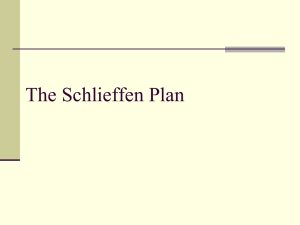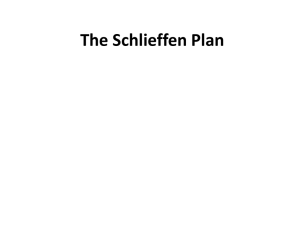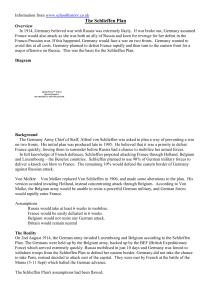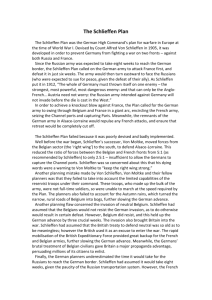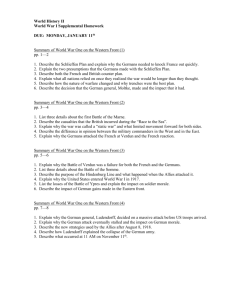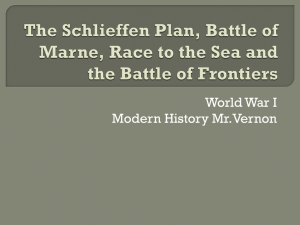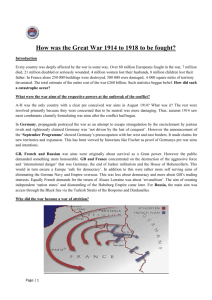THE SCHLIEFFEN PLAN
advertisement
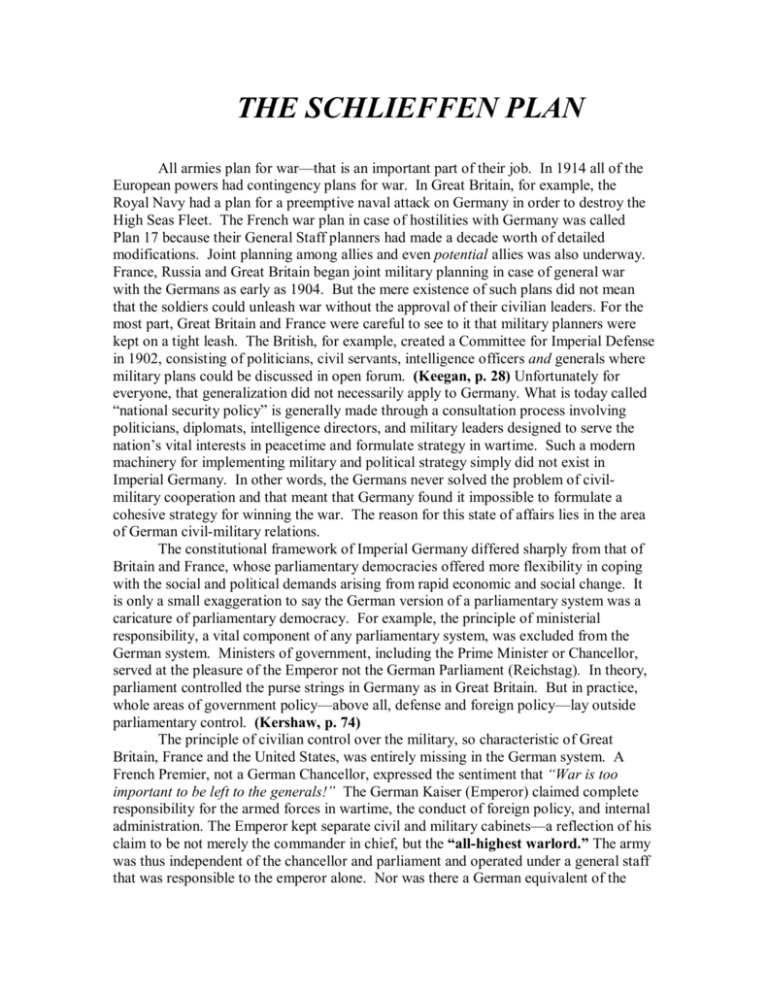
THE SCHLIEFFEN PLAN All armies plan for war—that is an important part of their job. In 1914 all of the European powers had contingency plans for war. In Great Britain, for example, the Royal Navy had a plan for a preemptive naval attack on Germany in order to destroy the High Seas Fleet. The French war plan in case of hostilities with Germany was called Plan 17 because their General Staff planners had made a decade worth of detailed modifications. Joint planning among allies and even potential allies was also underway. France, Russia and Great Britain began joint military planning in case of general war with the Germans as early as 1904. But the mere existence of such plans did not mean that the soldiers could unleash war without the approval of their civilian leaders. For the most part, Great Britain and France were careful to see to it that military planners were kept on a tight leash. The British, for example, created a Committee for Imperial Defense in 1902, consisting of politicians, civil servants, intelligence officers and generals where military plans could be discussed in open forum. (Keegan, p. 28) Unfortunately for everyone, that generalization did not necessarily apply to Germany. What is today called “national security policy” is generally made through a consultation process involving politicians, diplomats, intelligence directors, and military leaders designed to serve the nation’s vital interests in peacetime and formulate strategy in wartime. Such a modern machinery for implementing military and political strategy simply did not exist in Imperial Germany. In other words, the Germans never solved the problem of civil­ military cooperation and that meant that Germany found it impossible to formulate a cohesive strategy for winning the war. The reason for this state of affairs lies in the area of German civil­military relations. The constitutional framework of Imperial Germany differed sharply from that of Britain and France, whose parliamentary democracies offered more flexibility in coping with the social and political demands arising from rapid economic and social change. It is only a small exaggeration to say the German version of a parliamentary system was a caricature of parliamentary democracy. For example, the principle of ministerial responsibility, a vital component of any parliamentary system, was excluded from the German system. Ministers of government, including the Prime Minister or Chancellor, served at the pleasure of the Emperor not the German Parliament (Reichstag). In theory, parliament controlled the purse strings in Germany as in Great Britain. But in practice, whole areas of government policy—above all, defense and foreign policy—lay outside parliamentary control. (Kershaw, p. 74) The principle of civilian control over the military, so characteristic of Great Britain, France and the United States, was entirely missing in the German system. A French Premier, not a German Chancellor, expressed the sentiment that “War is too important to be left to the generals!” The German Kaiser (Emperor) claimed complete responsibility for the armed forces in wartime, the conduct of foreign policy, and internal administration. The Emperor kept separate civil and military cabinets—a reflection of his claim to be not merely the commander in chief, but the “all­highest warlord.” The army was thus independent of the chancellor and parliament and operated under a general staff that was responsible to the emperor alone. Nor was there a German equivalent of the 2 modern American Joint Chiefs of Staff in which the heads of all the armed services regularly review and debate defense policy. “In Germany, war planning belonged exclusively to the Great General Staff; the navy’s admirals were fed crumbs and even the Chancellor Bethmann­Holweg, was not told of the central war plan until December 1912 even though it had been in preparation since 1905. (Keegan, p. 28) According to the standard formulation, in Germany the army was “a state within the state.” Whenever a constitutional state fails to impose civilian control over the armed forces or allows the military exclusive or even undue influence in determining policy, that state can be described as “militaristic.” Militarists are not necessarily aggressors; they merely allow too much say to the soldiers when it comes to formulating national defense policy and strategy. Imperial Germany could thus serve as a textbook example of militarism in the modern world. Between 1870 and 1888, German strategy was formulated by Helmuth von Moltke (the Elder) (1800­1891) victor over Austria in 1866 and France in 1871. The Elder Moltke had few illusions about German prospects in a general European war. Recognizing that Germany faced two potentially dangerous continental rivals—a France eager for revenge and Russia with enormous manpower reserves—Moltke preferred to commit Germany to a defensive strategy. In case of war, Germany would stand on the defensive in the West and launch a limited offensive in the East against Russia. In 1879, the elder Moltke warned against the temptation to follow a victory against the Russian army in Poland by “pursuit into the Russian interior.” The elder Moltke exclaimed in a speech to the Reichstag: “Gentlemen [a general war] may turn into a seven, even a thirty years’ war! Woe betide him who sets Europe ablaze.” (Geyer, p. 530) In short, until the 1890s, the German army planned to dig in and try to wear down any potential invaders of the Reich. Until the end of his life, the Elder Moltke never stopped warning people that the France of 1888 was not the weak, isolated, and politically divided France of 1870. After the aged Moltke finally retired in 1888, the new Chief of the General Staff was Count Alfred von Waldersee, a political general content more or less to continue the defensive strategy of Moltke. (Chickering) The German Strategic Dilemma German strategic problems were and are a result of geography and politics. For example, Germany is poorly equipped to be a naval power for the simple reason that geography has dictated that the German coastline is blocked from access to the Atlantic Ocean by the great strategic breakwater of the British Isles. The same geographical factors apply for land warfare. Germany sits in central Europe between the Russia in the East and France in the West. Here is where politics enters the strategic equation. Since 1893, when France and Russia signed a mutual defense pact, the German General Staff anticipated that any European war would require that German forces fight on two fronts: in the east, against Russia, and in the west, against France. The threat of a two­front would force a fundamental change in German strategic thinking. A new German strategist would abandon the conservatism and caution of the Elder Moltke and commit Germany to the most famous and risky military strategy ever employed by a modern nation. Count Alfred von Schlieffen, (1833­1913) Germany’s Chief of the General Staff from 1891 to 1906, accepted a two­front war as inevitability 3 and formulated the war plan bears his name to solve the problem. Ironically, although Schlieffen died in 1913, he did more than anyone else to shape the First World War. Schlieffen, a cold and remote man, viewed the nations and armies of Europe much the same way a chess­master views his pieces on the board. Like a chess master, Schlieffen was willing to risk much and sacrifice pieces (i.e. soldiers) to gain a strategic advantage. Schlieffen’s strategy could also serve as a textbook example of the isolated, ivory tower strategist planning great operations without the slightest experience of the mud, blood, and screw­ups that Carl von Clausewitz called the “friction of war.” Although Schlieffen served as a staff officer in the war against Austria in 1866 and the Franco­Prussian war of 1870, he never commanded any troops in actual combat. The Schlieffen Plan, in the words of the British military historian Corelli Barnett, “reflected entirely the narrow militarism, [and] the ruthless and rigid theorizing of Schlieffen’s mind and personality.” (Barnett, p. 16) The intellectual problem Schlieffen set out to solve, and to him generalship was above all an intellectual pursuit, was how to win a short war against France and Russia with the military resources available to Germany. His ultimate ambition was to win a great European war against both Russia and France in a period of roughly seven weeks. Such a war would need to be quick and decisive, because, in his judgement, Germany could not possibly win a long “wearing out” war. (Keegan, p. 32) The first problem was to choose the most vulnerable opponent. Schlieffen worked on that problem for the first year of his tenure as Chief of the General Staff. In his assessment, France was weaker than Germany, but protected by very formidable fortifications along the common border. In the east, Schlieffen saw Russia, once again, a state he judged to be weaker than Germany, but protected by vast space. Schlieffen became convinced that a quick victory against Russia was unlikely because the Russians could simply retreat eastward as they had against Napoleon in 1812. (Keegan, p. 29) As we shall see, events proved Schlieffen to be in error. In the First World War, France turned out to be the most formidable opponent for Germany; in the Second World War, the USSR turned out to be a military superpower. Curiously enough, Schlieffen did not worry unduly about Great Britain. In his mind, Britain was a problem for diplomacy not military power. Although Great Britain possessed enormous economic power and the world’s greatest navy, Schlieffen ignored British military potential because Britain’s standing army was small and the war he planned would be over before the Royal Navy could possibly become a factor. In purely strategic terms, Germany’s position between two France and Russia gave her the advantage of interior lines. Germany also possessed a superb network of east­west railways that enabled her to move large masses of men relatively quickly from the French border to the Russian border. Schlieffen also calculated that Germany had an advantage over either potential opponent in the area of planning for a quick mobilization and deployment for attack. For these reasons, by 1892 he decided that France was the better target for a quick campaign. Of course, that decision led to many problems; above all, how to smash through the formidable French fortifications. He was reluctant to launch the German army directly against the French border fortifications because that course could lead to heavy loss of life. By 1894 he examined and rejected a number of schemes to destroy the French fortress system by the use of heavy artillery. This line of thought did pay some important dividends later in the war. The German army entered 4 the conflict with a big advantage in heavy artillery over the French army. Because Schlieffen was so interested in solving the problem of the French border fortresses, the Germans entered the war with 3.500 heavy artillery pieces to the French 300. (Horne, p. 15) Gradually, Schlieffen decided that even the heaviest artillery German industry could produce might not be up to the job. “By 1897, he began to think to himself that ‘the offensive must not shrink from violating the neutrality of Belgium and Luxembourg,’ in other words, neutralizing the French fortresses by outflanking them.”(Keegan, p. 30) The recipe for victory lay in making use of Germany's railway system to 1. Concentrate the bulk of the German army on the Belgian border; 2. To secure passage across the neutral country by force or diplomacy, and then simply overwhelm the French from the north and west before their army was ready. “The whole of Germany,” he wrote, “must throw itself on one enemy, the strongest, most powerful, most dangerous, and that can only be France.” (Tuchmann, p. 19) Schlieffen's plan thus allotted six weeks and 7/8th of the German army to smash France; while the remaining portion stood guard against the Russians. Obviously, there was a built­in time factor in the Schlieffen Plan. If the attack on France failed to bring about victory in six weeks, the Russians would have time to mobilize a huge force that could threaten Berlin itself. Clearly the Schlieffen Plan was a gamble on a gigantic scale. Even today one wonders why the military leaders of Germany placed so much faith in this strategy. For example, in the event of a military defeat, the bulk of the German army would be massed in Northern France while the eastern border of Germany would lie wide open to a Russian invasion. However Schlieffen and his successors discounted the possibility of failure or even the possibility that the French might somehow endure the attack and be in a position to continue the war. It is tempting to conclude that the German army fell victim to a shared delusion: That the Schlieffen Plan was indeed a recipe for inevitable victory. By 1905, just before his retirement, he cast all caution aside and called for an even more radical version of the strategy. In a document now called the Great Memorandum, Schlieffen wrote: “If possible, the German Army will win its battle by an envelopment with the right wing. This will therefore be made as strong as possible. For this purpose eight army corps and five cavalry divisions will cross the Meuse by five routes above Liège.” (Keegan, p. 32) He wanted above all, to avoid a long war. He wrote, “A strategy of attrition will not do if the maintenance of millions cost billions.” (Ibid.) The Devilish Details In terms of population, Germany should have been able to raise a trained army capable of overwhelming France. On paper, seventy million Germans had the advantage of fifty million French. But neither Schlieffen nor the German government attempted to expand the German army to anywhere near its potential size. Here again, political considerations provide a clue to strategy. The German ruling elite did not wish to expand the army if it meant corrupting the apolitical country men who made up the rank and file with large infusions of urban workers with socialist loyalties. The same sort of thinking led the German army to bar educated and patriotic Jewish citizens from the officer corps. The huge force necessary to envelop the French army would need 5 considerable space to deploy, hence the need to invade Belgium. By 1905, Schlieffen had become convinced Belgium could not provide the needed space for his monstrous right wing. He therefore expanded the invasion route to include Holland. However the decision to invade Belgium and Holland “solved” military and logistic problems at the cost of even greater diplomatic problems. Ultimately Schlieffen attempted to calculate the largest possible force that could march on France given the limitations of the railway and road systems of Belgium, Holland, and Northern France. Political and diplomatic concerns did not enter his thinking. Schlieffen’s strategy stands as a classic example of an attempt to solve political and diplomatic problems by the lavish application of military force. It was the Prussian philosopher Carl von Clausewitz who argued that, “War is the continuation of policy by other means.” By 1905, Schlieffen had made German foreign policy simply a minor factor to support a supposedly invincible military strategy. Here lies the fundamental flaw of the Schlieffen Plan. There is no fixed dividing line between war and politics. In short, the plan designed to bring a quick victory would almost inevitably bring both Great Britain and Russia into the war on the side of France. These powerful allies would likely shore up French resolve even in the face of the most serious French military defeat. There was no entity in the German government that could consider military strategy in a political context, aside from the person who happened to be Kaiser and “All highest War Lord” at any given moment. To say that Kaiser William II showed little ability or inclination in these areas would be a gross understatement. The problem for Germany, as Hew Strachan has recently written was, that “the German army could not live with the implications of this analysis.” (Strachan, p. 134) The reality of the alliance system in 1914 made a short, victorious war highly unlikely. In the words of Gwyn Dyer: Even as a purely technical military solution, it had grave defects; politically, it was a horror. To find the space necessary to move his huge army into France and take the French in the rear, Schlieffen planned an attack through neutral Belgium (although that would almost certainly bring Britain into the war against Germany too). Far worse, his plan committed Germany to attack France at the start of any war, even if the actual cause of the war should lie (as it eventually did) at the other end of Europe. His planning gave Germany’s civil authorities no political options—and the elaborate technical considerations that governed the process of mobilization for war left the civilians in a very weak position to demand changes when the crisis was upon them. (Dyer, p. 150) The plan also shackled German operational commanders. As his great wheeling movement was to sweep forward on a front of 300 kilometers with about thirty corps, each one would have only ten kilometers of front in which to make its advance. The precise road assignments for each German Corps in the marching wing had to be planned out and assigned ahead of time. To avoid marching columns thirty miles long, parallel roads had to be found and assigned to each Corps, division, and regiment. Only by such painstaking staff work, could the German forces advance the needed 20 miles per day. Even in 1905, Schlieffen worried that the road system itself, without any resistance from the Belgian army, could slow the German advance to a crawl. Schlieffen admitted the fundamental tactical problem facing Germany in his final draft of the plan. Any attempt 6 to increase the number of attacking troops would result in a huge traffic jam: “an unnecessary mass will be formed behind the firing­line.” Speed was essential but geography, mathematics, physics, and even human weariness could dislocate the whole plan. After all, the German Army of 1914 could only move rapidly as far as the railway extended. Once the German soldiers left the trains, the advance from the railheads to Paris required six weeks of forced marches. At best, soldiers march at a universal rate of four miles per hour. There was also little consideration for the plans of the enemy. Schlieffen wrote: “Should the English land and advance, the Germans will halt, defeat the English and continue the operation against the French.” The plan allocated no time for the defeat of the British Army. Obviously there was considerable wishful thinking and overconfidence in all this. The Kaiser’s order of the day for the German First Army on August 4, 1914 could not be more revealing: “Exterminate the treacherous English. Walk over [their] contemptibly small army.” (Strachan, p. 36) If the French managed to fall back, as Schlieffen put it: “if the French retreat [successfully] the war will be endless.” (Ibid., p. 33­35) In short, General Schlieffen was a gambler. Would the French, British and the Russians assume the roles assigned to them in the first six weeks of the war? That remained to be seen. Schlieffen died in 1913, and advised the officers gathered around his deathbed to invade France first and “keep the right wing strong.” (Wawro, p. 288) The willingness to stake everything on a single roll of the “iron dice” would be characteristic of German military strategy in both World Wars. Schlieffen’s successor Helmuth von Moltke made one significant change in the plan by limiting the German invasion to Belgium and allowing Holland to remain neutral. Moltke calculated that the disadvantage of reducing the space for German deployment would be offset by the potential economic and diplomatic advantage of Dutch neutrality. On August 3, 1914 the Germans launched 78 infantry divisions into Belgium and France. For a time, the plan seemed to be working. Belgium was overrun and the German Army seemed to be unbeatable. Then some small hitches occurred. The Belgians put up a more effective resistance that Schlieffen had thought possible. It was necessary to slow the advance and bring up the famous “Big Bertha” siege guns to take some strong fortresses around the city of Liège. More importantly, the Russian lived up to their treaty obligations with the French and launched a rapid invasion of East Prussia. On August 26, the German commander Helmuth von Moltke, (the Younger, 1848­ 1916) decided to take two corps from the advancing right wing and send them to the east. The Germans continued the advance but their striking power was reduced and their lines of communication and supply were already overextended. To make matters even worse, the small but tough British Expeditionary Force landed and provided strong support for the French. Why Did the Plan Fail? Historians and military strategists have expended an ocean of ink to explain the failure of the Schlieffen Plan. We have already examined the political problems, but the military flaws proved to be equally damaging. Ultimately, there are two general schools of thought. The first, argued by generations of military historians in particular, focuses 7 on operational decisions taken by the German commander in August, 1914: Helmuth von Moltke. Critics point out that Moltke tinkered with the master plan both before the war and during the critical weeks of August. His decision not to invade Holland, for example, bottled up German troops and logistics movements in the narrow Meuse River valley. Because of this, the right wing simply was not strong enough to deliver the war­winning blow against France. From the viewpoint of many military analysts, it was the professional failings and personal weaknesses of Moltke that led to failure. The Schlieffen Plan presupposed a strong hand at the controls to make sure every aspect of the complex plan unfolded within the rigid timeframe. The younger Moltke was clearly not the man for the job. By mid­August he was torn by self­doubt bordering on paralysis. By early September, he had reached the point of psychological collapse. One staff officer encountered Gen von Moltke on September 8 and found him: sitting hunched up over his table, his face buried in both hands. Moltke looked up and turned a pale and tear­stained face on the officer.” (Barnett, pp. 85­6) It is ironic that Moltke did not fit the image of the ruthless Prussian militarist that allied propagandists were busy creating in August 1914. Moltke was a thoughtful, even sensitive man wrestling with moral doubts and the fear that he was leading his country down the road to disaster. On the other hand, it is doubtful that even the most ruthless, focused, and amoral commander could have achieved a quick victory against France in August 1914. The second school of thought about the Schlieffen Plan is associated with the great German historian Gerhard Ritter, himself a veteran of the Great War. Ritter argued that the plan itself was flawed. The basic problem, according to Ritter, is that Schlieffen expected too much of the army. German troops were asked to do too much and march too far. Schlieffen assumed that the British, Russians, and French would play the roles he assigned them in his blueprint for victory. The logistics problems of equipping the German forces simply could not be solved. In short, for a plan of this complexity to work, everything must go right. No responsible commander can ever make such an assumption. In any event, the plan did not work and the war developed into a conflict no one wanted or anticipated. We began this lecture with a brief discussion of civil­military relations in Imperial Germany. From the very beginning, German strategy and statecraft was inextricably bound together, despite the best efforts of the German government to separate the two. The German goal of a quick, overwhelming defeat of France was at best a very unlikely outcome for reasons that far beyond the ability of the German Army to either understand or counteract. France did surrender to Prussia in 1870 but only because she could find no allies and was facing internal political collapse. In 1940 France surrendered to Germany once again because, as was the case in 1870, she lacked a Russian ally to threaten the eastern borders of Germany. In 1914, with both a British and a Russian ally, France was unlikely to surrender even after a severe military defeat. (Farrar, p. 27) The Schlieffen Plan also influenced British decisions. The invasion of Belgium may have been necessary from a purely military point of view to allow for a quick invasion of France. On the other hand, the violation of Belgian neutrality, guaranteed by Great Britain since the 1830s, virtually ensured a British entrance into the war. Although small, the British army was very important for the future. The first British soldier to land in France guaranteed that the war would become a world war. Even the first few 8 divisions of the BEF, dismissed by the Kaiser as “contemptible”, demonstrated British commitment to the war and thus gave the French every incentive to persevere even after an initial defeat. (Ibid., p. 28) In fact by 1917 Britain would take over the primary military burden on the Western Front.
